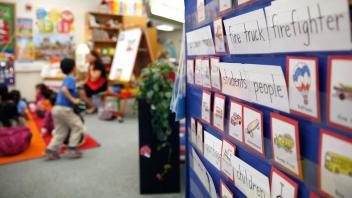Once there were word webs to explore synonyms with children.
Now there is a neat website called Visuwords , an online thesaurus and dictionary. It’s fun to see words bounce and connect. There’s even color coding to identify the parts of speech. (Thanks to a Reading Rockets colleague for the link!)
But like the ongoing discussion about the use of physical books (or hardcopy or low-tech books — whatever best describes them), do these materials stand alone or are they best used with physical materials — especially for younger children?
I may sound old-fashioned, but it seems to me that when using a physical book, there’s a lot more serendipitous discovery possible for a range of children. Take for example, the 2008 Merriam-Webster Children’s Dictionary . Childrenas young as 7 years old can check out a word in this attractive volume; they may find an additional word or a picture that intrigues them. And frankly it doesn’t need any other equipment except, of course, a light source by which to see.
There’s a lot of talk these days about replacing physical books with the digital variety. I for one don’t think that it’s a good idea to replace books entirely, especially for young children.
Rather, digital books and neat sites like Visuwords and other terrific sites intended for young users such as those recommended by the American Library Association, complement other experiences like dipping or delving into a book.
About the Author
Reading Rockets’ children’s literature expert, Maria Salvadore, brings you into her world as she explores the best ways to use kids’ books both inside — and outside — of the classroom.

